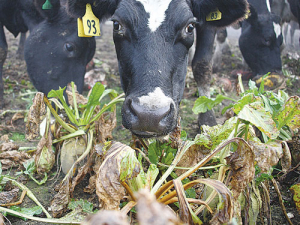A Bugger's Muddle
OPINION: Jacqueline Rowarth opined in Rural News, January 19, "Confusion abounds about agricultural greenhouse gases (GHGs) and misinformation is rife".
 Fodder beet was a standout, although its impact on methane emissions was less dramatic and consistent.
Fodder beet was a standout, although its impact on methane emissions was less dramatic and consistent.
Can changing what New Zealand livestock eat reduce the country’s emissions of methane and nitrous oxide?
Scientists are studying this as part of NZ’s aim to lower its greenhouse gas emissions to internationally agreed targets.
To help people understand the complexities in reducing agricultural greenhouse gas emissions, the farmer-supported Pastoral Greenhouse Gas Research Consortium (PGgRc) and NZ Agricultural Greenhouse Gas Research Centre (NZAGRC) have published fact sheets including one on low greenhouse gas emitting feeds.
Nearly 30 studies measuring methane emissions have been made of 17 different NZ feeds: pasture and various crops including brassicas, chicory, fodder beet, lucerne, maize and clovers.
Only two had noteworthy impacts on methane emissions. Brassica rape was the crop most rigorously tested. Compared to a traditional ryegrass/white clover pasture diet, a 100% brassica rape diet reduced emissions by an average of 30%.
Fodder beet was the other standout, although its impact on methane emissions was less dramatic and consistent. Trial results to date indicate it can reduce methane emissions by about 20%, but only when it makes up at least 70% of the diet.
A potential issue with brassica rape and fodder beet is the amount of nitrous oxide emissions created through urine leaching in NZ’s typically wet winter soil. More work is needed to see whether the decreases in methane emissions from these crops are sufficient to offset increases in nitrous oxide emissions.
Regardless, the research shows that large changes in diet are needed to effect much change in methane emissions from livestock.
The researchers conclude that there are no definitive, easy or dramatic ways to reduce emissions through diet alone.
Visit the PGgRC website to download a pdf of the fact sheet: http://www.pggrc.co.nz/
Fears of a serious early drought in Hawke’s Bay have been allayed – for the moment at least.
There was much theatre in the Beehive before the Government's new Resource Management Act (RMA) reform bills were introduced into Parliament last week.
The government has unveiled yet another move which it claims will unlock the potential of the country’s cities and region.
The government is hailing the news that food and fibre exports are predicted to reach a record $62 billion in the next year.
The final Global Dairy Trade (GDT) auction has delivered bad news for dairy farmers.
One person intimately involved in the new legislation to replace the Resource Management Act (RMA) is the outgoing chief executive of the Ministry for the Environment, James Palmer, who's also worked in local government.